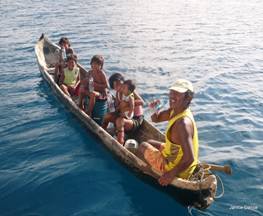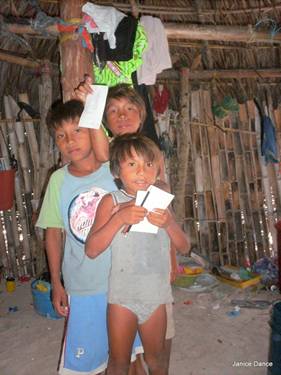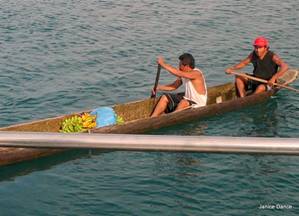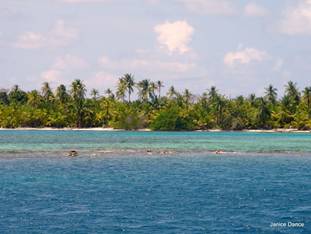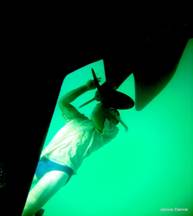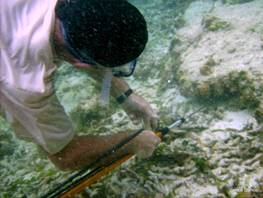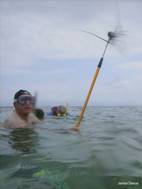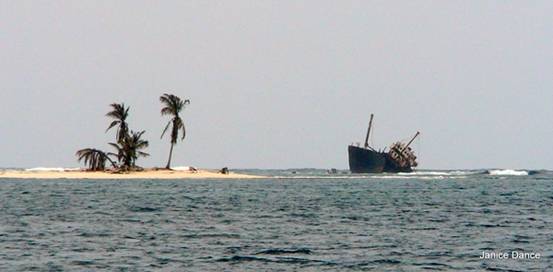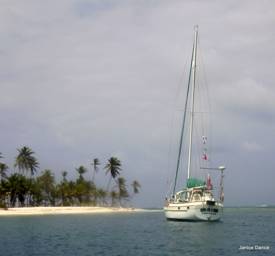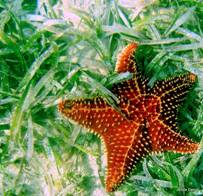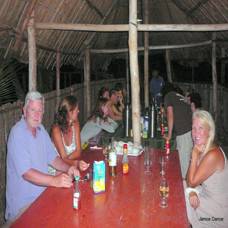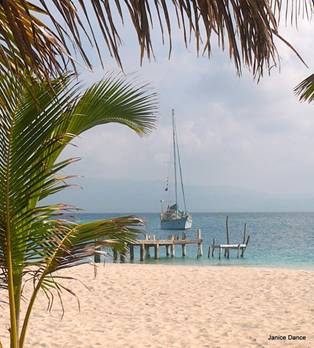The San Blas, Panama (2)

|
SO WHAT HAVE WE BEEN
UP TO, YOU ASK? Well our days seem to
have fallen into a pattern. On sailing days, we get up, have a leisurely
breakfast, raise the anchor, sail to the next island, drop anchor, eat, read,
chillax and sleep. On non sailing days,
we get up, have a leisurely breakfast, read a little, jump overboard and snorkel
for an hour or so, come back to the boat for lunch, snorkel, read, eat and sleep
and so the days go by. The only deviations
from the pattern are when we have ‘incoming’!! This is when we are being
approached by ulu’s wanting to trade with us. It’s a hard life, but somebody has
to do it L The days have been
very hot around about 32˚C + and despite slapping on factor 50 spf, we have
still got burned!!! However, the rainy
season is just beginning and we have had our first rainfall in 2
weeks. Shortly after we had
anchored off the
Senor Fernandez and
his wife and four children greeted us and then tried to sell me a Mola. As it is
the first island we have visited and we have another 6 weeks to go, I decided
not to buy one, but instead bought myself a bead bracelet, which I bargained
down from $4 to $2. Senor Fernandez
proudly introduced his children and told me they had been to school. The middle
boy, who told me he was ten years old, though he looked about seven, asked if I
had any magazines, so I gave him a National Geographic. I asked if they enjoyed
school and they said they had. I asked if they would like me to teach them some
English and Senor Fernandez said he would like that. So we arranged to visit his
home the next day at 11 am. Roger and I spent the
rest of the day snorkelling. It is so nice being able to snorkel off the boat
instead of having to dinghy to the reef. We saw a stingray and lots of other
smaller a fish. But the most exciting
thing was seeing a huge (about 4 ‘ wing span) spotted eagle ray. Unfortunately,
it was too deep for my camera to pick up, despite Roger diving down to snap
it.
They are all the same
and made of sustainable materials, bamboo walls and palm
roofs. Inside all they have is hammocks. The roofs can last between 10 and 25 years, it all depends on the length of time spent making it. If you take up to 2 years to make it, it will last up to 25 years!
Then we went on to
simple arithmetic. Jose and his middle brother were very bright, but when it
came to Cesar, Senor Fernandez, rather unkindly, knocked on his head, implying
he was dense. However, it soon became clear to me that this was not the case and
that Cesar was actually as bright as his brothers. All the family sat
round while we had our lesson (me too as I was having to work at my Spanish).
All the women had a cross painted down their nose, in what I presume was henna.
At one point Senor
Fernandez wanted to do the same to me. Part of me wanted to, but I didn’t know
if they tattooed it on, as the stick he showed me looked very sharp. Also I
wasn’t sure what the implications of having it done would be. So I just smiled
and said yes and carried on with my class. We had lots of laughs, especially
when it came to singing 10 green bottles!!! I didn’t see much
else of the settlement, except the women working on their Molas.
The next day we set
sail for Carti, in preparation for picking up Lynne and Chris. We sailed up from
Waisaladup and anchored off the
Men in ulus kept
stopping by the boat, so we bought 4 large fresh fish for $10 from one and 2
hands of green bananas for $1 from another. Green bananas are
great for not only do they last longer, but you can also cook them instead of
potatoes when they are green. However my top tip
for the day is: If you are peeling and cutting green bananas wear gloves as they
stain your hands dark brown!!! Bright and early
Roger set off to pick up our new crew and it was only minutes before they were
due. They had flown across
from
After a, yes,
leisurely breakfast of Bagels (courtesy of Cheryl in Although it was a
vast improvement on Nonomulu, being a palm fringed island as opposed to a
mangrove island, the snorkelling wasn’t very good with heavy sea surge making it
even more difficult at the same time reducing visibility.
There were however,
dozens of very large sea cucumbers everywhere, I have never seen sea cucumbers
that large, to give you an idea, they were probably the length of We decided to head
out the next day for
As soon as the anchor
was secure, Roger went overboard to check the anchor and Lynne & I sorted
out our snorkelling gear. Unfortunately, Chris was unable to snorkel as the gear we had on board was too small for him, it was probably just as well, as he was already doing a good impersonation of a lobster, despite being covered in factor 50 sunscreen.
However, before Roger
could snorkel he had to unravel the fishing line from the prop, as we had
forgotten to take it in before anchoring!!! The reef was a good
swim away from the boat, but it was excellent. Lots of marine life and big ‘drop
offs’, where we saw nurse sharks, sleeping, thankfully. They were the first
sharks we had seen this trip. The trouble with snorkelling is that you can do it for hours. I suppose it is like a child being in a toy shop, browsing. Time almost stands still. Plus, unlike diving, you have no air limitation, so one hour quickly slips into another. This is wonderfully relaxing, however, it also leaves you vulnerable to sun burn. Which, despite sunscreen, we all suffered with at one point or another.
Roger took his
Hawaiian sling with him (a spear for fishing that works a bit like a catapult)
as he needed the practice and we set off for the reef. It wasn’t long before we
spotted a lobster and Roger tried to spear it. As I said, he needed the practice
and the lobster was not for eating that day. Within minutes we had spotted another (that’s my job) and Roger came for a crack at it. He had more success this time as the lobster made the fatal error of trying to swim for it!! (he obviously prefers a moving target!)
Sadly, despite being
kept in water, because of his wound, unlike the lobsters that the locals dive
for and somehow bring up uninjured, he was not fit for eating when I came to
cook him the next day. The next day we
dinked round to the other anchorage of Swimming Pool and BBQ islands just to
have a look. It was just like an NCP car park, there were so many yachts and they all looked as if they were lined up. We were so glad we hadn’t anchored there, it sort of spoils the illusion of the isolation of the islands.
That day, while we
were all chillaxing an ulu approached. It was driven by an outboard, most are
paddled. We exchanged the usual pleasantries and one of the men gave us his
business card. His name was Venancio and he was a Master Mola Maker. Just what I
had been waiting for. Although everyone makes Molas, the quality of the work
varies greatly, but the Master Mola Makers produce exceptional work. Stitches so
fine you can’t even see them. I had decided that if I were going to buy a Mola
it would be from a Master. Venancio asked if he could come aboard to show his
work, Roger reluctantly agreed. We sat in the cockpit
and went through all of his work. He had traditional designs, ‘historia’ designs
(that told a particular story) and tourist designs. They were all beautiful. So
we selected the ones we liked, then whittled it down to the ones we would
purchase. Venancio told me their island was 3hours away, he also gave me his
brothers’ business card. Idelfonso is a tour guide. He speaks very good English
and we learned what little Kuna we speak from him. I suggested that we should do
a trip with him, so we agreed to call him the night before we wanted to visit
his island. We had read that the Coco Banderos islands were amongst the most beautiful in the Kuna Yala, so the next day, after paying our $5 fee to the local Kuna, we upped anchor and headed over. Unfortunately the other 16 yachts that were anchored there when we arrived must have read the same book, so here we were in another NCP car park. There was also a dramatic reminder of just how dangerous the reefs were, as we passed a ship that had been wrecked!
We slowly nosed our
way through the reef, then through all of the yachts, we passed the little
islands and I for one was rather saddened to see that some of the cruisers had
put up gazebos on the beaches. Seriously, it was
like
It was beautiful
there was no question about that. The reef was within swimming distance, so it
was fine. There was also a huge
motor yacht anchored just outside the anchorage. With it came 2 tenders and 2
wet bikes!!! We watched as the
crew also brought the owners’ 2 standard poodles across to our island to do
their ablutions. Once again I thought how arrogant, as there was no way they had
cleaned up after the dogs and there were Kuna living on the island. I also
thought about how little the huge yacht brought to the people of the islands. I
doubt very much that they ever traded with the ulus when they came to sell their
wares. At least, in return
for sharing these beautiful islands, cruisers contribute to its economy. In fact
it is quite a significant amount. While we were checking in I was talking to the
Port Captain asking him how many yachts visited the islands each year (remember
he felt he should have a secretary and Now, on top of that
you are sometimes required to pay $5 to the local Sahila (chief of the island)
for anchoring in his waters. Most cruisers will
buy at least 1 Mola during their stay and they start at about $10, but the
average price is probably $30, so there’s $30,000 going to the local people
directly. All the fish and produce you buy and the taxes you pay to the
congresso if you visit an island. If you are allowed to take photos, most Kuna
will charge you $1 for the privilege, so it doesn’t take Einstein to work out
that it is a significant contribution over the year. In addition to that
cruisers will often bring magazines, sweets and drinks to give to the
Kuna. Anyway, I think you
get the picture, so I’ll get off my soap box and continue with our
journey. As the reef was so
close, we donned our gear and headed out. Once again it was excellent. We had
taken to wearing t-shirts over our swimming gear, to protect ourselves from the
sun. As was our practice after a snorkel, it was back to the boat for tea and cookies (and to wake Chris up, he was the ‘Swab’ and did most of the heavy work and it was tiring him out!!!!) then spend the rest of the day chillaxing.
We have a ‘lookee
bucket’ on board, which is a glass bottomed bucket, so Lynne and Roger decided
to take Chris over to the reef and show him the marine life. As it was
approaching sunset I stayed on board (well all the predators start coming out
then and I don’t like snorkelling with them, don’t mind diving, but not
snorkelling). Lynne was only wearing her bikini and as she was swimming she felt
something bite her. It was so startling that she fished around in her bikini to
get whatever it was out. Later, after she had
been back on board a while she went to lay down, as she was experiencing unusual
stabbing pains followed by aches. I gave her paracetamol and asked her to
monitor the situation. I have a little book on board about health in the
We took the dink over
to one of the islands which seemed to be of no interest to anyone else It was
quite a distance, but we were rewarded with spectacular snorkelling.
There were huge
corals and a mass of different species of fish. We swam quite a distance and
spent a couple of hours exploring before returning to the island. The island
itself was beautiful with a pristine white beach all the way round. On the
windward side of the island were lots of empty conch shells. We hadn’t seen any
on the leeward side, so presumably they prefer the strong current and
surge. As Lynne and
Chris were on board Roger tried to do as much sailing as possible, which
wasn’t always easy as the next island may ave been as little as 20 minutes
away and hardly worth the effort of getting the sails set. But our next
destination, Kuanidup, was a good 3 hours away. The winds were light
(but at least in the right direction for a change) so we broke out the spinnaker
and
Now Kuanidup is an
small island with a kuna style hotel on it. This is a few Kuna style huts,
hammocks slung between palm trees and a ‘comidor’ or canteen
hut. We dinked ashore and asked if we could dine there that evening. The young man we spoke to said yes, the meal would be fish and it is served at 7pm.
Over a couple of bottles of wine and an excellent dinner of grilled fish, salad, coleslaw, rice and beans, we passed a pleasant evening with the guests (more like a meeting of the UN, there were so many different nationalities) and all for $15 a head (the meal itself was only $6, the balance was for the wine, which, by the way, was the same price we had paid in the supermarkets in Cartagena).
|
